Strategic HRM: Embedding HR Strategies in Corporate Goals Essay
VerifiedAdded on 2023/04/19
|8
|2613
|203
Essay
AI Summary
This essay explores the critical role of Strategic Human Resource Management (SHRM) in aligning HR strategies with broader corporate objectives, using Tesla as a case study. It emphasizes the importance of embedding HR strategies to ensure workforce efficiency, talent retention, and alignment with organizational goals like revenue, cost management, and risk mitigation. The essay analyzes how HR practices, including training, development, and welfare systems, contribute to building a skilled and motivated workforce, enhancing customer satisfaction, and adapting to market dynamics and government regulations. It also discusses the implementation process of HR strategies at the departmental level, highlighting the need for clear communication, employee cooperation, and evaluation through SMART goals. Furthermore, the essay addresses contemporary HR challenges facing Tesla, such as production capacity, financial sustainability, investor trust, leadership assistance, and regulatory compliance, underscoring the necessity of integrating HR strategies with corporate strategies to navigate complex situations and achieve sustainable growth. Desklib provides numerous resources for students.
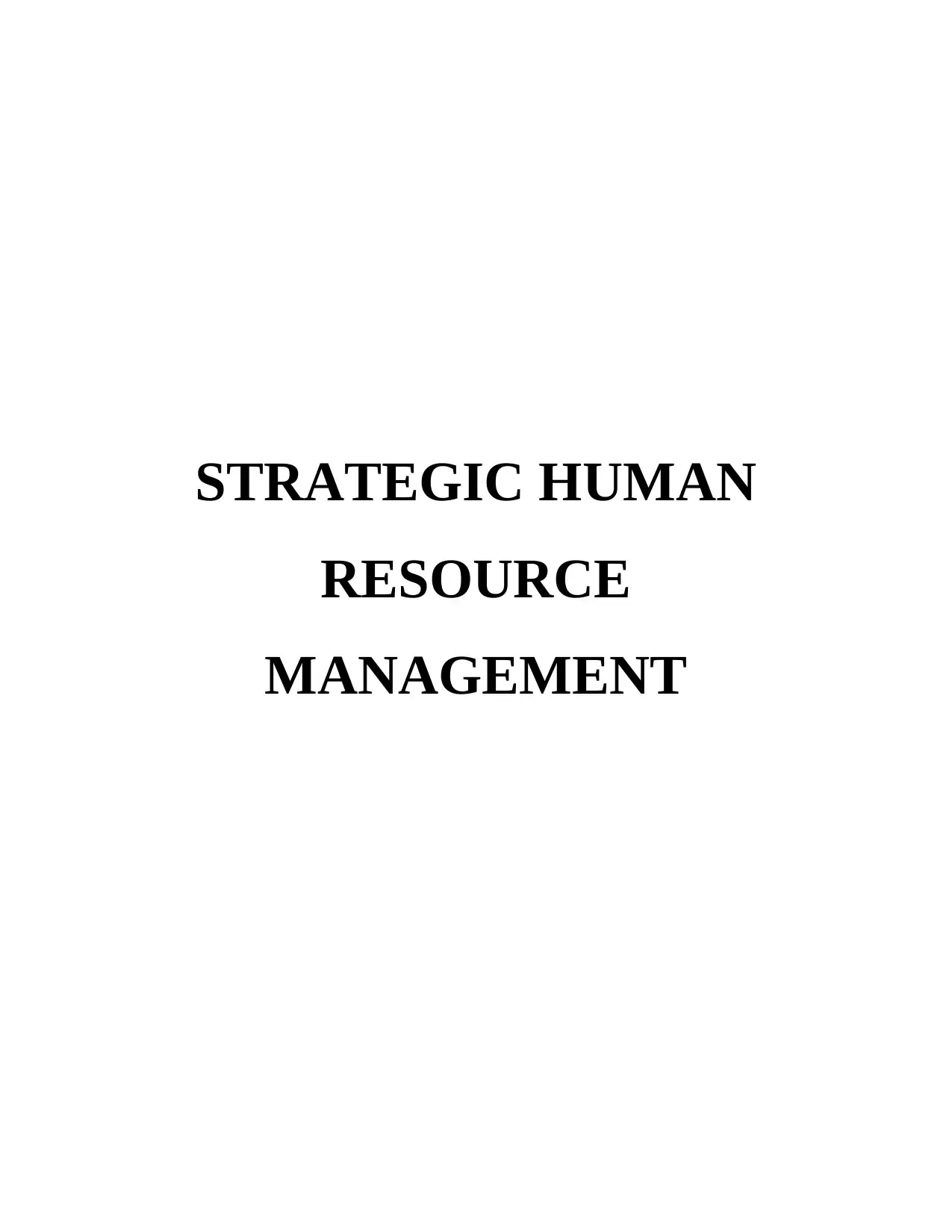
STRATEGIC HUMAN
RESOURCE
MANAGEMENT
RESOURCE
MANAGEMENT
Paraphrase This Document
Need a fresh take? Get an instant paraphrase of this document with our AI Paraphraser
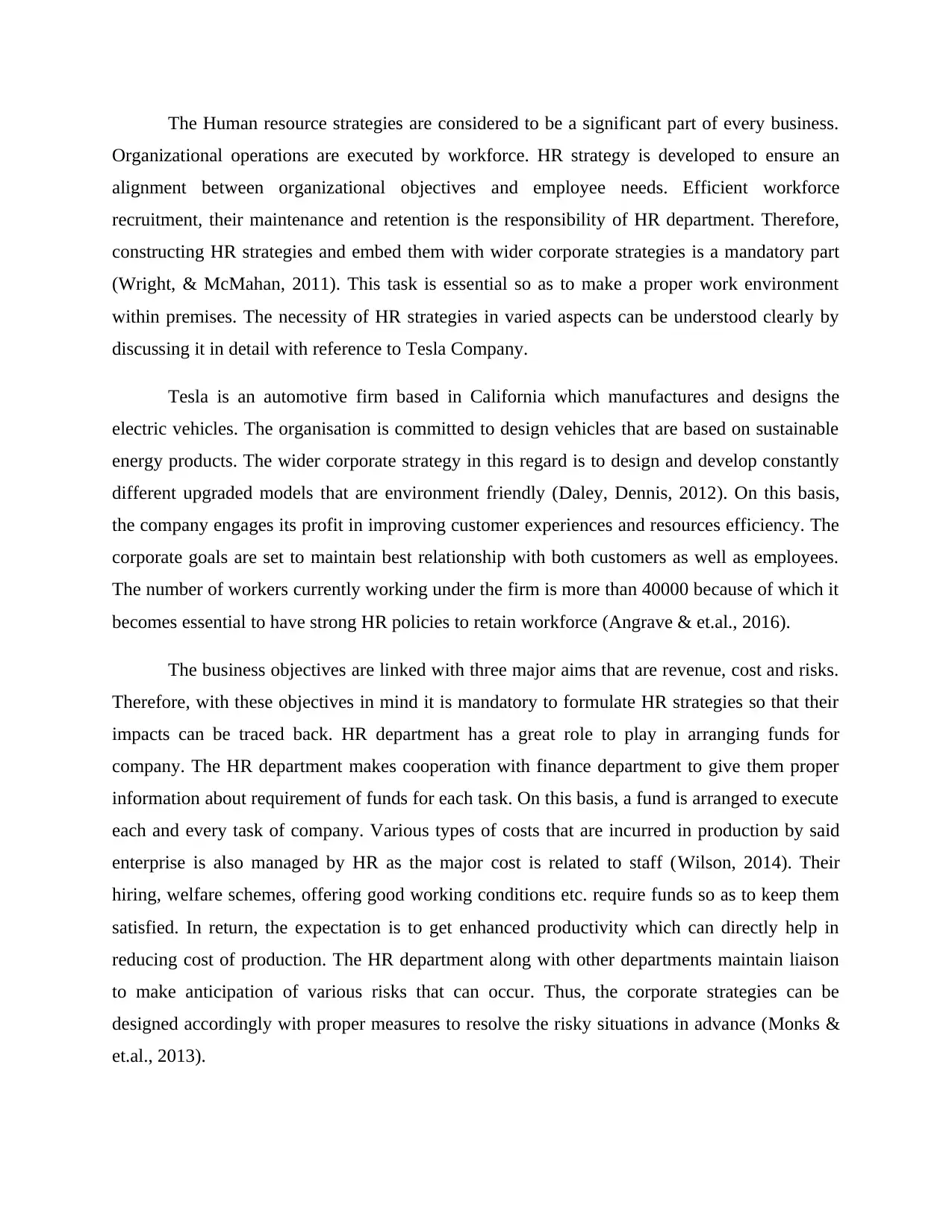
The Human resource strategies are considered to be a significant part of every business.
Organizational operations are executed by workforce. HR strategy is developed to ensure an
alignment between organizational objectives and employee needs. Efficient workforce
recruitment, their maintenance and retention is the responsibility of HR department. Therefore,
constructing HR strategies and embed them with wider corporate strategies is a mandatory part
(Wright, & McMahan, 2011). This task is essential so as to make a proper work environment
within premises. The necessity of HR strategies in varied aspects can be understood clearly by
discussing it in detail with reference to Tesla Company.
Tesla is an automotive firm based in California which manufactures and designs the
electric vehicles. The organisation is committed to design vehicles that are based on sustainable
energy products. The wider corporate strategy in this regard is to design and develop constantly
different upgraded models that are environment friendly (Daley, Dennis, 2012). On this basis,
the company engages its profit in improving customer experiences and resources efficiency. The
corporate goals are set to maintain best relationship with both customers as well as employees.
The number of workers currently working under the firm is more than 40000 because of which it
becomes essential to have strong HR policies to retain workforce (Angrave & et.al., 2016).
The business objectives are linked with three major aims that are revenue, cost and risks.
Therefore, with these objectives in mind it is mandatory to formulate HR strategies so that their
impacts can be traced back. HR department has a great role to play in arranging funds for
company. The HR department makes cooperation with finance department to give them proper
information about requirement of funds for each task. On this basis, a fund is arranged to execute
each and every task of company. Various types of costs that are incurred in production by said
enterprise is also managed by HR as the major cost is related to staff (Wilson, 2014). Their
hiring, welfare schemes, offering good working conditions etc. require funds so as to keep them
satisfied. In return, the expectation is to get enhanced productivity which can directly help in
reducing cost of production. The HR department along with other departments maintain liaison
to make anticipation of various risks that can occur. Thus, the corporate strategies can be
designed accordingly with proper measures to resolve the risky situations in advance (Monks &
et.al., 2013).
Organizational operations are executed by workforce. HR strategy is developed to ensure an
alignment between organizational objectives and employee needs. Efficient workforce
recruitment, their maintenance and retention is the responsibility of HR department. Therefore,
constructing HR strategies and embed them with wider corporate strategies is a mandatory part
(Wright, & McMahan, 2011). This task is essential so as to make a proper work environment
within premises. The necessity of HR strategies in varied aspects can be understood clearly by
discussing it in detail with reference to Tesla Company.
Tesla is an automotive firm based in California which manufactures and designs the
electric vehicles. The organisation is committed to design vehicles that are based on sustainable
energy products. The wider corporate strategy in this regard is to design and develop constantly
different upgraded models that are environment friendly (Daley, Dennis, 2012). On this basis,
the company engages its profit in improving customer experiences and resources efficiency. The
corporate goals are set to maintain best relationship with both customers as well as employees.
The number of workers currently working under the firm is more than 40000 because of which it
becomes essential to have strong HR policies to retain workforce (Angrave & et.al., 2016).
The business objectives are linked with three major aims that are revenue, cost and risks.
Therefore, with these objectives in mind it is mandatory to formulate HR strategies so that their
impacts can be traced back. HR department has a great role to play in arranging funds for
company. The HR department makes cooperation with finance department to give them proper
information about requirement of funds for each task. On this basis, a fund is arranged to execute
each and every task of company. Various types of costs that are incurred in production by said
enterprise is also managed by HR as the major cost is related to staff (Wilson, 2014). Their
hiring, welfare schemes, offering good working conditions etc. require funds so as to keep them
satisfied. In return, the expectation is to get enhanced productivity which can directly help in
reducing cost of production. The HR department along with other departments maintain liaison
to make anticipation of various risks that can occur. Thus, the corporate strategies can be
designed accordingly with proper measures to resolve the risky situations in advance (Monks &
et.al., 2013).

The customers can be retained by enhancing the value proposition which improves
customer satisfaction (Jackson, Schuler & Jiang, 2014). Secondly, the HR strategies include
tailoring staff motivation, training and development practices which directly impact the
employees’ knowledge and mindset. Therefore, HR practices help in building better sales force
by meeting corporate goal of creating value proposition and customer satisfaction (Deery &
Jago, 2015).
The stated firm is completely based on proficient engineering qualities to design the
electric vehicles. It is mandatory to keep employees up to date with modern dynamics. HR
department makes policies regarding attendance, training and development, compensations and
welfare systems that help in retaining the workforce (Marler & Fisher, 2013). Besides this, they
are made aware of corporate goals so that they have a developed understanding about the
demands of organisation with them. Further, HR strategies also help in understanding the market
situation to firm so as to be aware of the trend of demands among consumers. So by creating
value proposition through professional staff, the organisation manages to grow demand of
customers and satisfy it (Wright & McMahan, 2011).
The demand in market is impacted by government regulations that are quite volatile for
automotive industry. Therefore, including HR department while formulation of corporate
strategies, becomes compulsory so that they can create policies that are flexible. The blend of
HR strategies with corporate strategies will help in coming up with better practices and ideas to
handle any situation. The dynamic environment of market poses a number of threats that are
required to be managed strategically. Therefore, the HR department can help in getting a proper
idea of each situation to each department (DuBois & Dubois, 2012). This will aid in getting a
right solution for the issues and get them resolved on time.
The implementation process of HR strategies at departmental level is a compulsory
function which must be carried out in a structured way. Before implementation, it is essential to
make each department understand about its necessity (Barratt-Pugh, Bahn & Gakere, 2013). By
conveying clearly about the necessity, employees’ cooperation can be gained. Along with this, in
order to get successful implementation, expectations must be communicated to the whole
department. As per this, the entire list should be made regarding the tasks that can be done
through this. After developing the HR polices, the process related to developing mission and
customer satisfaction (Jackson, Schuler & Jiang, 2014). Secondly, the HR strategies include
tailoring staff motivation, training and development practices which directly impact the
employees’ knowledge and mindset. Therefore, HR practices help in building better sales force
by meeting corporate goal of creating value proposition and customer satisfaction (Deery &
Jago, 2015).
The stated firm is completely based on proficient engineering qualities to design the
electric vehicles. It is mandatory to keep employees up to date with modern dynamics. HR
department makes policies regarding attendance, training and development, compensations and
welfare systems that help in retaining the workforce (Marler & Fisher, 2013). Besides this, they
are made aware of corporate goals so that they have a developed understanding about the
demands of organisation with them. Further, HR strategies also help in understanding the market
situation to firm so as to be aware of the trend of demands among consumers. So by creating
value proposition through professional staff, the organisation manages to grow demand of
customers and satisfy it (Wright & McMahan, 2011).
The demand in market is impacted by government regulations that are quite volatile for
automotive industry. Therefore, including HR department while formulation of corporate
strategies, becomes compulsory so that they can create policies that are flexible. The blend of
HR strategies with corporate strategies will help in coming up with better practices and ideas to
handle any situation. The dynamic environment of market poses a number of threats that are
required to be managed strategically. Therefore, the HR department can help in getting a proper
idea of each situation to each department (DuBois & Dubois, 2012). This will aid in getting a
right solution for the issues and get them resolved on time.
The implementation process of HR strategies at departmental level is a compulsory
function which must be carried out in a structured way. Before implementation, it is essential to
make each department understand about its necessity (Barratt-Pugh, Bahn & Gakere, 2013). By
conveying clearly about the necessity, employees’ cooperation can be gained. Along with this, in
order to get successful implementation, expectations must be communicated to the whole
department. As per this, the entire list should be made regarding the tasks that can be done
through this. After developing the HR polices, the process related to developing mission and
⊘ This is a preview!⊘
Do you want full access?
Subscribe today to unlock all pages.

Trusted by 1+ million students worldwide
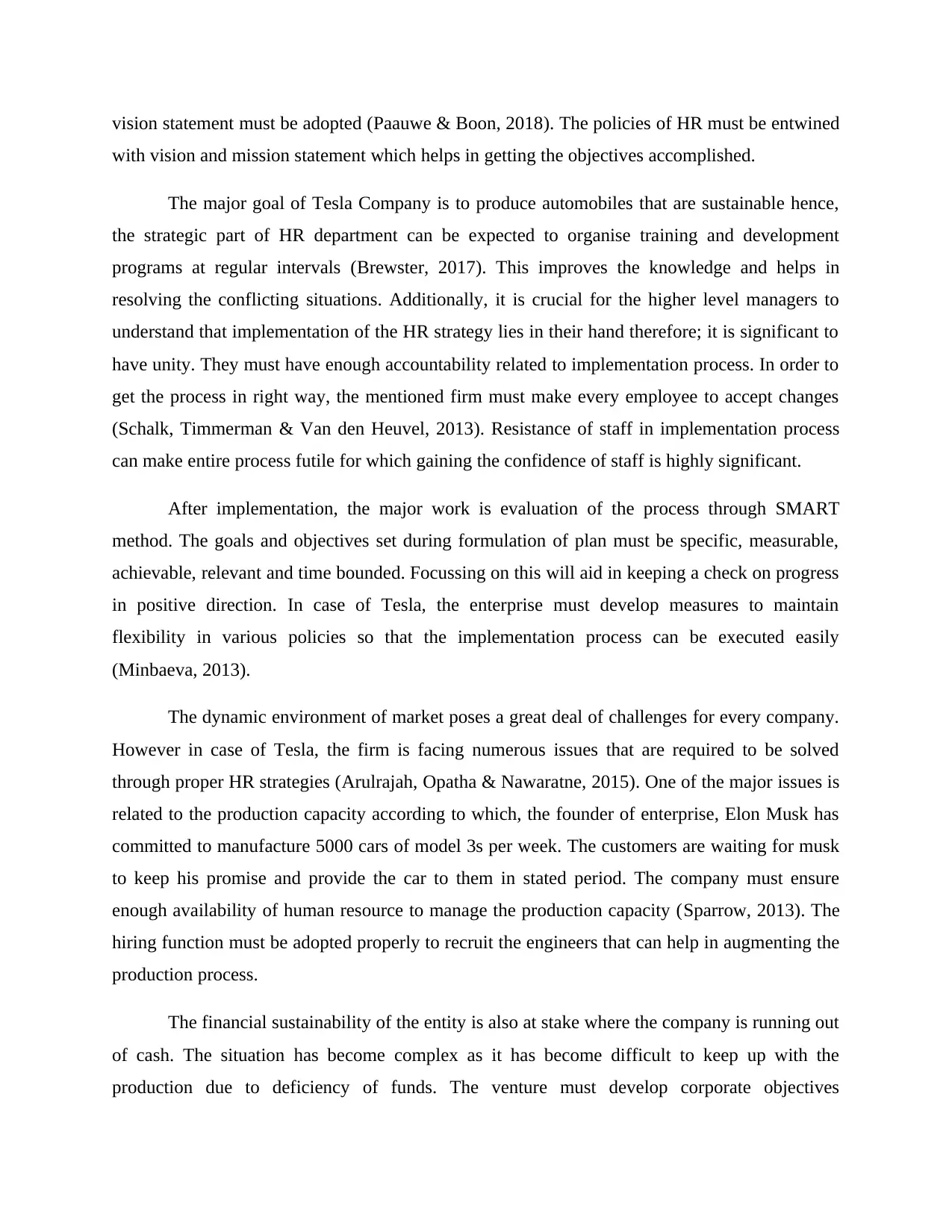
vision statement must be adopted (Paauwe & Boon, 2018). The policies of HR must be entwined
with vision and mission statement which helps in getting the objectives accomplished.
The major goal of Tesla Company is to produce automobiles that are sustainable hence,
the strategic part of HR department can be expected to organise training and development
programs at regular intervals (Brewster, 2017). This improves the knowledge and helps in
resolving the conflicting situations. Additionally, it is crucial for the higher level managers to
understand that implementation of the HR strategy lies in their hand therefore; it is significant to
have unity. They must have enough accountability related to implementation process. In order to
get the process in right way, the mentioned firm must make every employee to accept changes
(Schalk, Timmerman & Van den Heuvel, 2013). Resistance of staff in implementation process
can make entire process futile for which gaining the confidence of staff is highly significant.
After implementation, the major work is evaluation of the process through SMART
method. The goals and objectives set during formulation of plan must be specific, measurable,
achievable, relevant and time bounded. Focussing on this will aid in keeping a check on progress
in positive direction. In case of Tesla, the enterprise must develop measures to maintain
flexibility in various policies so that the implementation process can be executed easily
(Minbaeva, 2013).
The dynamic environment of market poses a great deal of challenges for every company.
However in case of Tesla, the firm is facing numerous issues that are required to be solved
through proper HR strategies (Arulrajah, Opatha & Nawaratne, 2015). One of the major issues is
related to the production capacity according to which, the founder of enterprise, Elon Musk has
committed to manufacture 5000 cars of model 3s per week. The customers are waiting for musk
to keep his promise and provide the car to them in stated period. The company must ensure
enough availability of human resource to manage the production capacity (Sparrow, 2013). The
hiring function must be adopted properly to recruit the engineers that can help in augmenting the
production process.
The financial sustainability of the entity is also at stake where the company is running out
of cash. The situation has become complex as it has become difficult to keep up with the
production due to deficiency of funds. The venture must develop corporate objectives
with vision and mission statement which helps in getting the objectives accomplished.
The major goal of Tesla Company is to produce automobiles that are sustainable hence,
the strategic part of HR department can be expected to organise training and development
programs at regular intervals (Brewster, 2017). This improves the knowledge and helps in
resolving the conflicting situations. Additionally, it is crucial for the higher level managers to
understand that implementation of the HR strategy lies in their hand therefore; it is significant to
have unity. They must have enough accountability related to implementation process. In order to
get the process in right way, the mentioned firm must make every employee to accept changes
(Schalk, Timmerman & Van den Heuvel, 2013). Resistance of staff in implementation process
can make entire process futile for which gaining the confidence of staff is highly significant.
After implementation, the major work is evaluation of the process through SMART
method. The goals and objectives set during formulation of plan must be specific, measurable,
achievable, relevant and time bounded. Focussing on this will aid in keeping a check on progress
in positive direction. In case of Tesla, the enterprise must develop measures to maintain
flexibility in various policies so that the implementation process can be executed easily
(Minbaeva, 2013).
The dynamic environment of market poses a great deal of challenges for every company.
However in case of Tesla, the firm is facing numerous issues that are required to be solved
through proper HR strategies (Arulrajah, Opatha & Nawaratne, 2015). One of the major issues is
related to the production capacity according to which, the founder of enterprise, Elon Musk has
committed to manufacture 5000 cars of model 3s per week. The customers are waiting for musk
to keep his promise and provide the car to them in stated period. The company must ensure
enough availability of human resource to manage the production capacity (Sparrow, 2013). The
hiring function must be adopted properly to recruit the engineers that can help in augmenting the
production process.
The financial sustainability of the entity is also at stake where the company is running out
of cash. The situation has become complex as it has become difficult to keep up with the
production due to deficiency of funds. The venture must develop corporate objectives
Paraphrase This Document
Need a fresh take? Get an instant paraphrase of this document with our AI Paraphraser
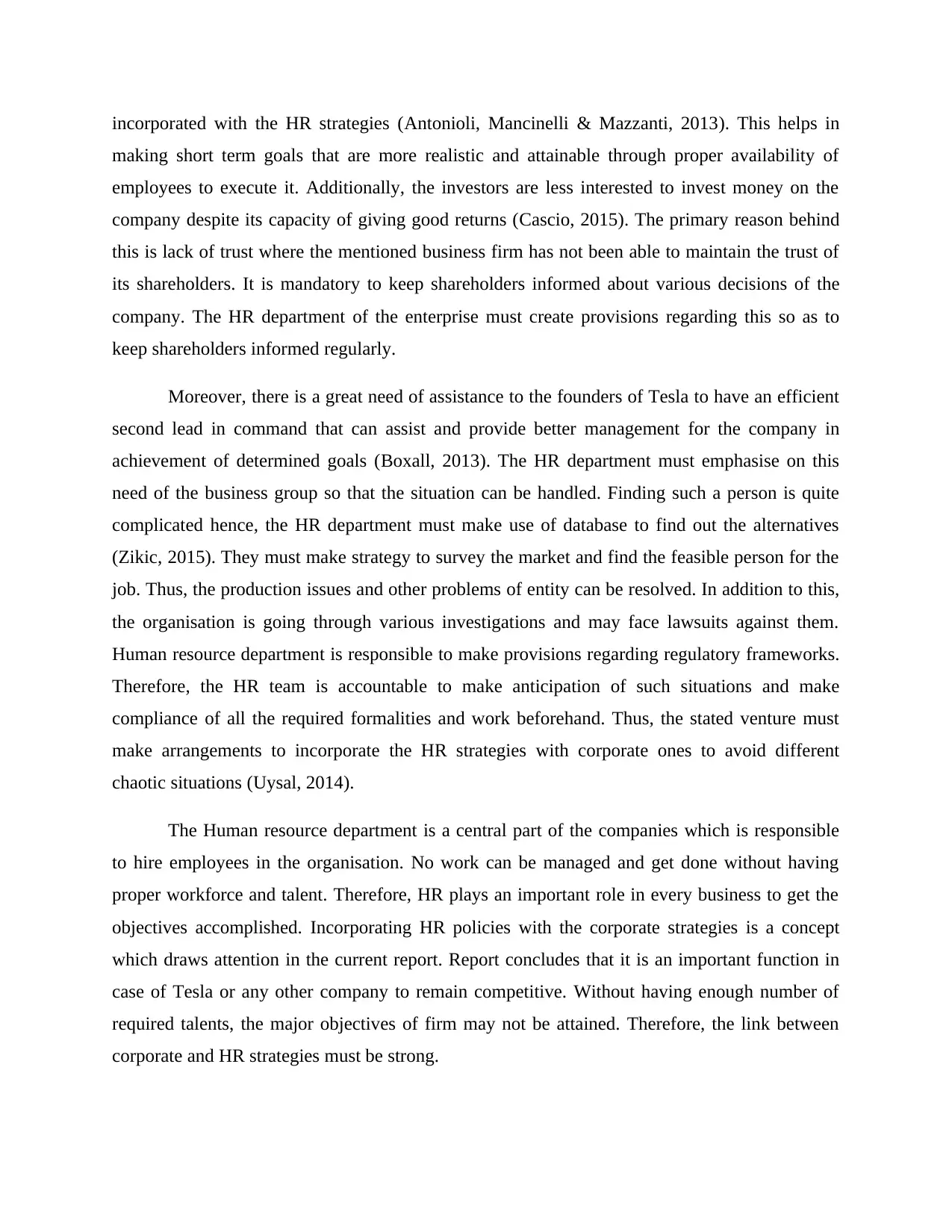
incorporated with the HR strategies (Antonioli, Mancinelli & Mazzanti, 2013). This helps in
making short term goals that are more realistic and attainable through proper availability of
employees to execute it. Additionally, the investors are less interested to invest money on the
company despite its capacity of giving good returns (Cascio, 2015). The primary reason behind
this is lack of trust where the mentioned business firm has not been able to maintain the trust of
its shareholders. It is mandatory to keep shareholders informed about various decisions of the
company. The HR department of the enterprise must create provisions regarding this so as to
keep shareholders informed regularly.
Moreover, there is a great need of assistance to the founders of Tesla to have an efficient
second lead in command that can assist and provide better management for the company in
achievement of determined goals (Boxall, 2013). The HR department must emphasise on this
need of the business group so that the situation can be handled. Finding such a person is quite
complicated hence, the HR department must make use of database to find out the alternatives
(Zikic, 2015). They must make strategy to survey the market and find the feasible person for the
job. Thus, the production issues and other problems of entity can be resolved. In addition to this,
the organisation is going through various investigations and may face lawsuits against them.
Human resource department is responsible to make provisions regarding regulatory frameworks.
Therefore, the HR team is accountable to make anticipation of such situations and make
compliance of all the required formalities and work beforehand. Thus, the stated venture must
make arrangements to incorporate the HR strategies with corporate ones to avoid different
chaotic situations (Uysal, 2014).
The Human resource department is a central part of the companies which is responsible
to hire employees in the organisation. No work can be managed and get done without having
proper workforce and talent. Therefore, HR plays an important role in every business to get the
objectives accomplished. Incorporating HR policies with the corporate strategies is a concept
which draws attention in the current report. Report concludes that it is an important function in
case of Tesla or any other company to remain competitive. Without having enough number of
required talents, the major objectives of firm may not be attained. Therefore, the link between
corporate and HR strategies must be strong.
making short term goals that are more realistic and attainable through proper availability of
employees to execute it. Additionally, the investors are less interested to invest money on the
company despite its capacity of giving good returns (Cascio, 2015). The primary reason behind
this is lack of trust where the mentioned business firm has not been able to maintain the trust of
its shareholders. It is mandatory to keep shareholders informed about various decisions of the
company. The HR department of the enterprise must create provisions regarding this so as to
keep shareholders informed regularly.
Moreover, there is a great need of assistance to the founders of Tesla to have an efficient
second lead in command that can assist and provide better management for the company in
achievement of determined goals (Boxall, 2013). The HR department must emphasise on this
need of the business group so that the situation can be handled. Finding such a person is quite
complicated hence, the HR department must make use of database to find out the alternatives
(Zikic, 2015). They must make strategy to survey the market and find the feasible person for the
job. Thus, the production issues and other problems of entity can be resolved. In addition to this,
the organisation is going through various investigations and may face lawsuits against them.
Human resource department is responsible to make provisions regarding regulatory frameworks.
Therefore, the HR team is accountable to make anticipation of such situations and make
compliance of all the required formalities and work beforehand. Thus, the stated venture must
make arrangements to incorporate the HR strategies with corporate ones to avoid different
chaotic situations (Uysal, 2014).
The Human resource department is a central part of the companies which is responsible
to hire employees in the organisation. No work can be managed and get done without having
proper workforce and talent. Therefore, HR plays an important role in every business to get the
objectives accomplished. Incorporating HR policies with the corporate strategies is a concept
which draws attention in the current report. Report concludes that it is an important function in
case of Tesla or any other company to remain competitive. Without having enough number of
required talents, the major objectives of firm may not be attained. Therefore, the link between
corporate and HR strategies must be strong.
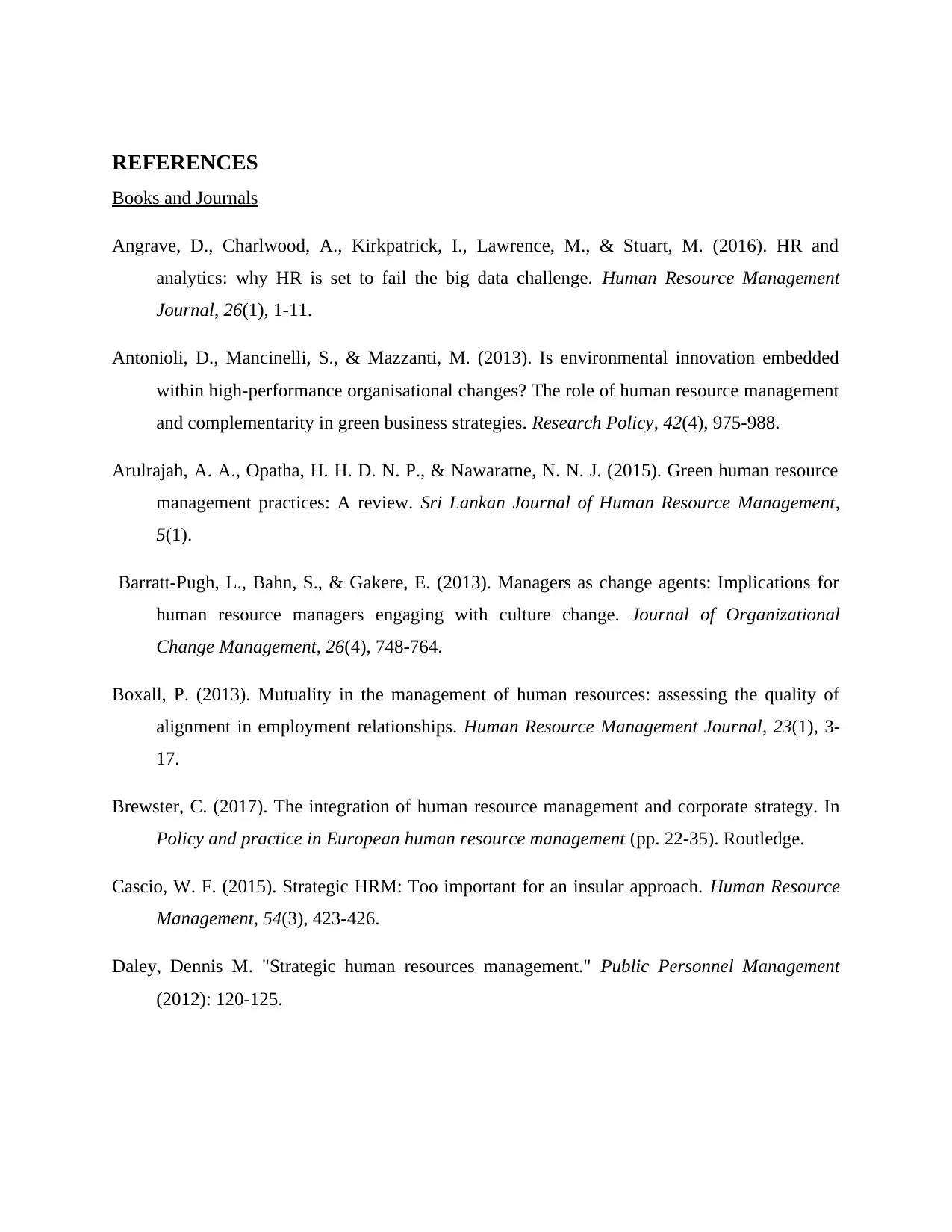
REFERENCES
Books and Journals
Angrave, D., Charlwood, A., Kirkpatrick, I., Lawrence, M., & Stuart, M. (2016). HR and
analytics: why HR is set to fail the big data challenge. Human Resource Management
Journal, 26(1), 1-11.
Antonioli, D., Mancinelli, S., & Mazzanti, M. (2013). Is environmental innovation embedded
within high-performance organisational changes? The role of human resource management
and complementarity in green business strategies. Research Policy, 42(4), 975-988.
Arulrajah, A. A., Opatha, H. H. D. N. P., & Nawaratne, N. N. J. (2015). Green human resource
management practices: A review. Sri Lankan Journal of Human Resource Management,
5(1).
Barratt-Pugh, L., Bahn, S., & Gakere, E. (2013). Managers as change agents: Implications for
human resource managers engaging with culture change. Journal of Organizational
Change Management, 26(4), 748-764.
Boxall, P. (2013). Mutuality in the management of human resources: assessing the quality of
alignment in employment relationships. Human Resource Management Journal, 23(1), 3-
17.
Brewster, C. (2017). The integration of human resource management and corporate strategy. In
Policy and practice in European human resource management (pp. 22-35). Routledge.
Cascio, W. F. (2015). Strategic HRM: Too important for an insular approach. Human Resource
Management, 54(3), 423-426.
Daley, Dennis M. "Strategic human resources management." Public Personnel Management
(2012): 120-125.
Books and Journals
Angrave, D., Charlwood, A., Kirkpatrick, I., Lawrence, M., & Stuart, M. (2016). HR and
analytics: why HR is set to fail the big data challenge. Human Resource Management
Journal, 26(1), 1-11.
Antonioli, D., Mancinelli, S., & Mazzanti, M. (2013). Is environmental innovation embedded
within high-performance organisational changes? The role of human resource management
and complementarity in green business strategies. Research Policy, 42(4), 975-988.
Arulrajah, A. A., Opatha, H. H. D. N. P., & Nawaratne, N. N. J. (2015). Green human resource
management practices: A review. Sri Lankan Journal of Human Resource Management,
5(1).
Barratt-Pugh, L., Bahn, S., & Gakere, E. (2013). Managers as change agents: Implications for
human resource managers engaging with culture change. Journal of Organizational
Change Management, 26(4), 748-764.
Boxall, P. (2013). Mutuality in the management of human resources: assessing the quality of
alignment in employment relationships. Human Resource Management Journal, 23(1), 3-
17.
Brewster, C. (2017). The integration of human resource management and corporate strategy. In
Policy and practice in European human resource management (pp. 22-35). Routledge.
Cascio, W. F. (2015). Strategic HRM: Too important for an insular approach. Human Resource
Management, 54(3), 423-426.
Daley, Dennis M. "Strategic human resources management." Public Personnel Management
(2012): 120-125.
⊘ This is a preview!⊘
Do you want full access?
Subscribe today to unlock all pages.

Trusted by 1+ million students worldwide
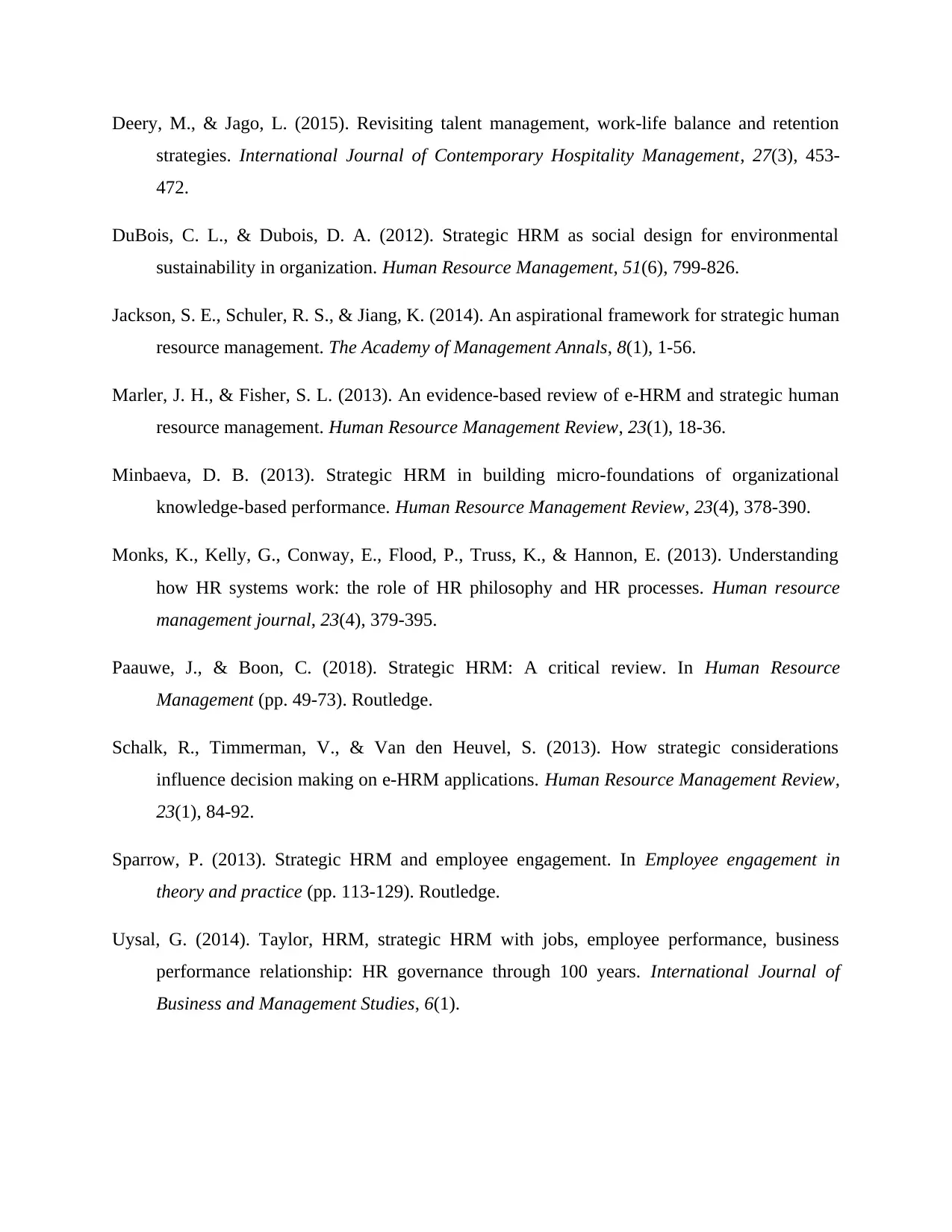
Deery, M., & Jago, L. (2015). Revisiting talent management, work-life balance and retention
strategies. International Journal of Contemporary Hospitality Management, 27(3), 453-
472.
DuBois, C. L., & Dubois, D. A. (2012). Strategic HRM as social design for environmental
sustainability in organization. Human Resource Management, 51(6), 799-826.
Jackson, S. E., Schuler, R. S., & Jiang, K. (2014). An aspirational framework for strategic human
resource management. The Academy of Management Annals, 8(1), 1-56.
Marler, J. H., & Fisher, S. L. (2013). An evidence-based review of e-HRM and strategic human
resource management. Human Resource Management Review, 23(1), 18-36.
Minbaeva, D. B. (2013). Strategic HRM in building micro-foundations of organizational
knowledge-based performance. Human Resource Management Review, 23(4), 378-390.
Monks, K., Kelly, G., Conway, E., Flood, P., Truss, K., & Hannon, E. (2013). Understanding
how HR systems work: the role of HR philosophy and HR processes. Human resource
management journal, 23(4), 379-395.
Paauwe, J., & Boon, C. (2018). Strategic HRM: A critical review. In Human Resource
Management (pp. 49-73). Routledge.
Schalk, R., Timmerman, V., & Van den Heuvel, S. (2013). How strategic considerations
influence decision making on e-HRM applications. Human Resource Management Review,
23(1), 84-92.
Sparrow, P. (2013). Strategic HRM and employee engagement. In Employee engagement in
theory and practice (pp. 113-129). Routledge.
Uysal, G. (2014). Taylor, HRM, strategic HRM with jobs, employee performance, business
performance relationship: HR governance through 100 years. International Journal of
Business and Management Studies, 6(1).
strategies. International Journal of Contemporary Hospitality Management, 27(3), 453-
472.
DuBois, C. L., & Dubois, D. A. (2012). Strategic HRM as social design for environmental
sustainability in organization. Human Resource Management, 51(6), 799-826.
Jackson, S. E., Schuler, R. S., & Jiang, K. (2014). An aspirational framework for strategic human
resource management. The Academy of Management Annals, 8(1), 1-56.
Marler, J. H., & Fisher, S. L. (2013). An evidence-based review of e-HRM and strategic human
resource management. Human Resource Management Review, 23(1), 18-36.
Minbaeva, D. B. (2013). Strategic HRM in building micro-foundations of organizational
knowledge-based performance. Human Resource Management Review, 23(4), 378-390.
Monks, K., Kelly, G., Conway, E., Flood, P., Truss, K., & Hannon, E. (2013). Understanding
how HR systems work: the role of HR philosophy and HR processes. Human resource
management journal, 23(4), 379-395.
Paauwe, J., & Boon, C. (2018). Strategic HRM: A critical review. In Human Resource
Management (pp. 49-73). Routledge.
Schalk, R., Timmerman, V., & Van den Heuvel, S. (2013). How strategic considerations
influence decision making on e-HRM applications. Human Resource Management Review,
23(1), 84-92.
Sparrow, P. (2013). Strategic HRM and employee engagement. In Employee engagement in
theory and practice (pp. 113-129). Routledge.
Uysal, G. (2014). Taylor, HRM, strategic HRM with jobs, employee performance, business
performance relationship: HR governance through 100 years. International Journal of
Business and Management Studies, 6(1).
Paraphrase This Document
Need a fresh take? Get an instant paraphrase of this document with our AI Paraphraser
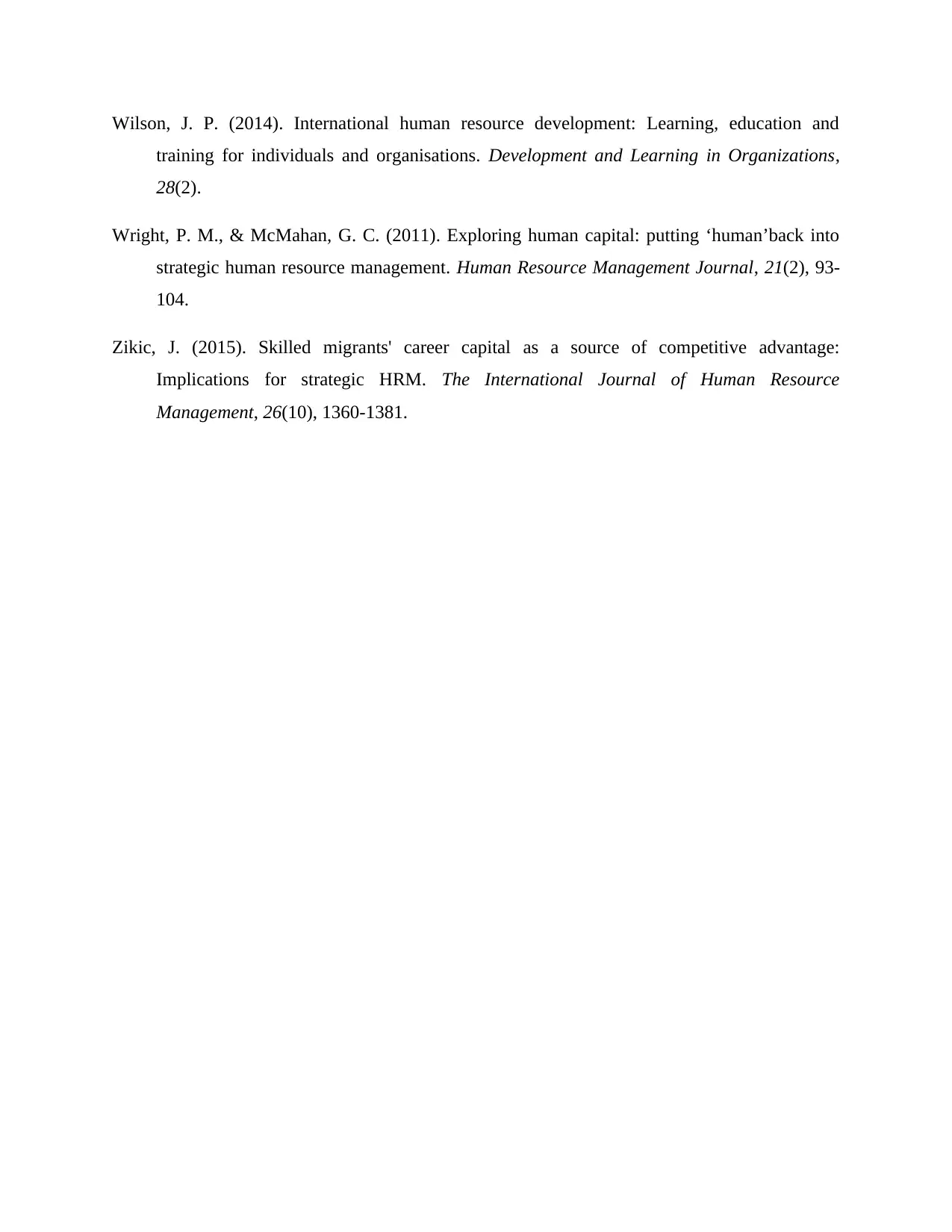
Wilson, J. P. (2014). International human resource development: Learning, education and
training for individuals and organisations. Development and Learning in Organizations,
28(2).
Wright, P. M., & McMahan, G. C. (2011). Exploring human capital: putting ‘human’back into
strategic human resource management. Human Resource Management Journal, 21(2), 93-
104.
Zikic, J. (2015). Skilled migrants' career capital as a source of competitive advantage:
Implications for strategic HRM. The International Journal of Human Resource
Management, 26(10), 1360-1381.
training for individuals and organisations. Development and Learning in Organizations,
28(2).
Wright, P. M., & McMahan, G. C. (2011). Exploring human capital: putting ‘human’back into
strategic human resource management. Human Resource Management Journal, 21(2), 93-
104.
Zikic, J. (2015). Skilled migrants' career capital as a source of competitive advantage:
Implications for strategic HRM. The International Journal of Human Resource
Management, 26(10), 1360-1381.
1 out of 8
Related Documents
Your All-in-One AI-Powered Toolkit for Academic Success.
+13062052269
info@desklib.com
Available 24*7 on WhatsApp / Email
![[object Object]](/_next/static/media/star-bottom.7253800d.svg)
Unlock your academic potential
Copyright © 2020–2025 A2Z Services. All Rights Reserved. Developed and managed by ZUCOL.




